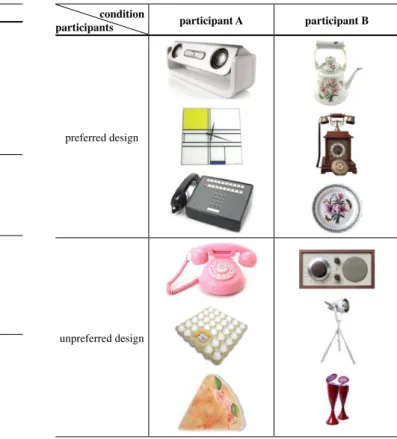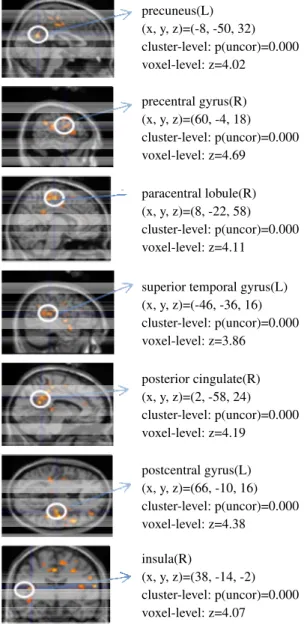THE BEAUTY OF PRODUCT DESIGN IS NOT ENOUGH TO ATTRACT CONSUMERS’ MIND
全文
(2) Kansei Engineering International Vol.8 No.2. condition. materials. condition participants. participant A. participant B. classic design. preferred design. beautiful design modern design. postmodern design. unpreferred design. ugly design. common and ugly design. Figure 1: Examples of experimental materials of beautiful and ugly design conditions.. Figure 2: Examples of experimental materials for preferred vs. unpreferred design conditions.. campus via web advertisement participated in this study. Participants were all right-handed, with normal visual acuity and normal history of any psychiatric or medical illness.. compared with each other and with the control condition by SPM99 and SPM 5.. 2.2.2 Stimuli Photos of 9 different daily goods (audio speaker, radio, desk lamp, telephone, clock, scale, etc.) were used in the experiment. After identifying the subjects’ preference on product design at pre-test, 15 photos of preferred design and 15 photos of unpreferred design photos were presented (Figure 2).. 3.1 Neural activations Neural activations are presented in Table 1, Table 2, Figure 3 and Figure 4.. 3. RESULTS. 3.2. Product beauty itself cannot touch consumers’ emotion deeply Compared with ugly designs, beautiful product designs activated the lingual gyrus only. The lingual gyrus is one part of the visual cortex and related to visual recognition (Fink, Marshall, Weiss, Shsh, Toni, Halligan and Zilles, 2000). This result implies that consumers are “seeing” the products without any emotional responses. On the other hand, preferred product design leads more activation in insula, an area related to emotional response, especially in detection of physical arousal such as sexual arousal (Critchley, Rotshtein, Nagai, O’Doherty, Mathias and Dolan 2005; Iaria, 2008).. 2.2.3 Experimental Design The experiment consisted of two experimental conditions (one preferred design and one unpreferred design condition) and one control condition (fixation). (50 sec/ block, new image in every 2.5 sec, each image presented for 2 sec, blank for 0.5 sec, within subject). 2.2.4 Brain Data Acquisition and Analysis The data was acquired by using an ISOL 3.0 Tesla forte MRI scanner (TR=2500ms, TE=35ms, 5mm no gap 20 slices, 64X64 matrix, FOV 240mm, flip angle 80) and analyzed using a random effects analysis (p<0.01, uncorrected). The results of experimental conditions were. 3.3 Preferred design moves consumers’ body implicitly One remarkable finding in this study is the activation of the precentral and the postcentral gyri in preferred product. 138.
(3) THE BEAUTY OF PRODUCT DESIGN IS NOT ENOUGH TO ATTRACT CONSUMERS’ MIND. Table 1: Direct comparison between neural activations in beautiful design condition (beautiful design-ugly design) and ugly design condition (ugly design-beautiful design). beautiful design visual process. lingual gyrus(R) [24, -84, -14]. precuneus(L) (x, y, z)=(-8, -50, 32) cluster-level: p(uncor)=0.000 voxel-level: z=4.02. ugly design none of specific activations. precentral gyrus(R) (x, y, z)=(60, -4, 18) cluster-level: p(uncor)=0.000 voxel-level: z=4.69. lingual gyrus(R) (x, y, z)=(24, -84, -14) cluster-level: p(uncor)=0.000 voxel-level: z=4.55. paracentral lobule(R) (x, y, z)=(8, -22, 58) cluster-level: p(uncor)=0.000 voxel-level: z=4.11. Figure 3: Neural activations in beautiful design condition(beautiful design-ugly design).. superior temporal gyrus(L) (x, y, z)=(-46, -36, 16) cluster-level: p(uncor)=0.000 voxel-level: z=3.86. Table 2: Direct comparison between neural activations in preferred design condition (preferred design conditionunpreferred design) and unpreferred design condition. preferred design. unpreferred design. emotion. insula(R) [46, -16, 10] insula(L) [-40, -10, 14] paracentral lobule(R) [8, -22, 58]. none of specific activations. visual process. superior temporal gyrus(L) [-46, -36, 16]. none of specific activations. somatosensory. precentral gyrus(R) [60, -4, 18] postcentral gyrus(R) [66, -10, 16]. postcentral gyrus(L) (x, y, z)=(66, -10, 16) cluster-level: p(uncor)=0.000 voxel-level: z=4.38. memory. posterior cingulate gyrus(R) [2, -58, 24] posterior cingulate gyrus(L) [-6, -54, 22] precuneus (L) [-8, -50, 32]. insula(R) (x, y, z)=(38, -14, -2) cluster-level: p(uncor)=0.000 voxel-level: z=4.07. posterior cingulate(R) (x, y, z)=(2, -58, 24) cluster-level: p(uncor)=0.000 voxel-level: z=4.19. Figure 4: Neural activations in preferred design condition (preferred design condition- unpreferred design).. design condition. These regions are known as motor and somatosensory areas and are also activated when people imagine movements and touches (Bocher, Chisin, Parag, Freedman, MeirWeil, Lester, Mishani and Bonne, 2001; Mouras, Stoleru, Bittoun, Glutron, Issac, Paradis and Burnod, 2003). In the experiment, we didn’t ask participants neither to move their body nor to imagine movement. However, they seem to have imagined themselves to touch, grip, rub the product and to have tried to feel the sense of touch automatically and implicitly. Furthermore, the participants did not see the product passively, but interacted with the product actively.. These findings suggest that the beauty of the product design itself cannot evoke emotional response alone and therefore consumer research should be preceded when a company plans to launch a new product design. Especially, present study is meaningful in that it discovered the limitation of existing method of measurement that measure the emotional response about good design by self-report. Also, when they make new product design in business, they should have idea what design moves consumer’s mind.. 4. CONCLUSION REFERENCES 1. P.H. Bloch; Seeking the ideal form: Product design and consumer response. Journal of Marketing, 59, pp.16-29 (1995). 2. M. Bocher, R. Chisin, Y. Parag, N. Freedman; Y. Meir. The results showed that brain activation is connected with only visual process during good design condition, but brain activations are connected with emotion and visual process during preferred product design condition.. 139.
(4) Kansei Engineering International Vol.8 No.2. 3.. 4.. 5.. 6. 7.. 8. 9.. 10.. 11.. Bo Kyung KIM Bo Kyung KIM is a graduate student in psychology department at Stanford University, USA. Her researches are related to neural basis of human decision making – especially consumer behavior and economic decision making. This includes both how we learn the value of goods and actions in the world and how we use this information to decide between different actions. Recent work has particularly emphasized the function of the midbrain dopamine system and how this interacts with areas in the prefrontal and parietal cortices to produce decisions. Main research theme is to investigate how individual (e.g. age, personality) and environmental (e.g. social context) differences are reflected concomitantly in brain function and behavior.. Weil, H. Lester, E. Mishani, and O. Bonne, Cerebral Activation Associated with Sexual Arousal in Response to a Pornographic Clip: A 15OH2O PET Study in Heterosexual Men, NeuroImage, 14(1), pp.105-117 (2001). Margaret Bruce and Maureen Whitehead; Putting Design into the Picture: The Role of Product Design in Consumer Purchase Behavior. Journal of the Market Research Society, 30(2), pp.147-62 (1988). H. D. Critchley, P. Rotshtein, Y. Nagai, J. O’Doherty, C. J. Mathias, and R. J. Dolan; Activity in the human brain predicting differential heart rate responses to emotional facial expressions, NeuroImage, 24(3), pp.751-762 (2005). G. R. Fink, J. C. Marshall, P. H. Weiss, N. J. Shsh, Halligan P. W. Toni, and K. Zilles; ‘Where’ depends on ‘What’: a differential functional anatomy for position discrimination in one- versus two-dimensions. Neuropsychologia, 38(18), pp.1741-1748 (2000). A. Forty; Object of desire. New York: Pantheon Books (1986). M.B. Holbrook; Aims, concepts, and methods for the representation of individual differences in aesthetic response the design feature. Journal of consumer research, 13(3), pp.337-347 (1986). B. Hollins, and P. Stuart; Successful product design. London: Butterworths (1990). G. Iaria, G. Committeri, C. Pastorelli, L. Pizzamiglio, K. E. Watkins, and A. Carota; Neural activity of the anterior insula in emotional processing depends on the individuals’ emotional susceptibility. Human Brain Mapping, 29: pp.363-373 (2008). H. Mouras, S. Stoleru, J. Bittoun, D. Glutron, M. P. Issac, A. L. Paradis, and Y. Burnod; “Brain processing of visual sexual stimuli in healthy men; a functional magnetic resonance imaging study”. Neuroimage, 20(2), pp.855-869 (2003). B. Nussbaum; For Noel Zeller, Good design is just the beginning, business Week, Jun 7, pp.54-57 (1993).. Joo Won LEE Joo Won LEE is a graduate student in psychology department at KOREA University, Korea. Her researches are related to neural basis of psychology – especially preference of product design and beauty seeking behaviors. Major areas of research interests include art psychology, design psychology, and advertising psychology, because her major was a fine art in university. Min SON Min SON is a graduate student in department of psychology at Korea University of consumer and advertisement psychology, Korea. He has been studied about the psychological influence in product design. Functional magnetic resonance machine was used for his study. And now days he has interest in media psychology. Kwang Yeol CHOI Kwang Yeol CHOI is a graduate student in psychology department at Korea University, South Korea. His research is related to neural basis of visual perception – especially preference of product design. This investigates the cognitive and emotional process with consumers experience while they attend to preferred product design. These days he is concerned about implicit memory effect of advertisement and male beauty seeking behaviors.. Young Shin SUNG Young Shin SUNG is professor and head of the department of Psychology at Korea University. She is also director of BK21 brain-based psychology project. She was former president of Korean Society of Consumer Studies (KSCS), Korean Society for Consumer and Advertising Psychology (KSCS), and former vice president of Korean Psychological Association (KPA). Major areas of research interests include consumer psychology, advertising psychology, and decision making applying quantitative and qualitative methods as well as neuroscientific method such as fMRI.. 140.
(5)
図


関連したドキュメント
of the conference on ergodic theory and related topics, II (Georgenthal, 1986), Teubner-Texte Math. Misiurewicz , Dimension of invariant measures for maps with ex- ponent zero,
An example of a database state in the lextensive category of finite sets, for the EA sketch of our school data specification is provided by any database which models the
Since locally closed functions with all point inverses closed have closed graphs [2], (c) implies
A NOTE ON SUMS OF POWERS WHICH HAVE A FIXED NUMBER OF PRIME FACTORS.. RAFAEL JAKIMCZUK D EPARTMENT OF
THIS PRODUCT IS LICENSED UNDER THE VC-1 PATENT PORTFOLIO LICENSE FOR THE PERSONAL AND NON-COMMERCIAL USE OF A CONSUMER TO (ⅰ) ENCODE VIDEO IN COMPLIANCE WITH THE VC-1
For staggered entry, the Cox frailty model, and in Markov renewal process/semi-Markov models (see e.g. Andersen et al., 1993, Chapters IX and X, for references on this work),
A lemma of considerable generality is proved from which one can obtain inequali- ties of Popoviciu’s type involving norms in a Banach space and Gram determinants.. Key words
de la CAL, Using stochastic processes for studying Bernstein-type operators, Proceedings of the Second International Conference in Functional Analysis and Approximation The-